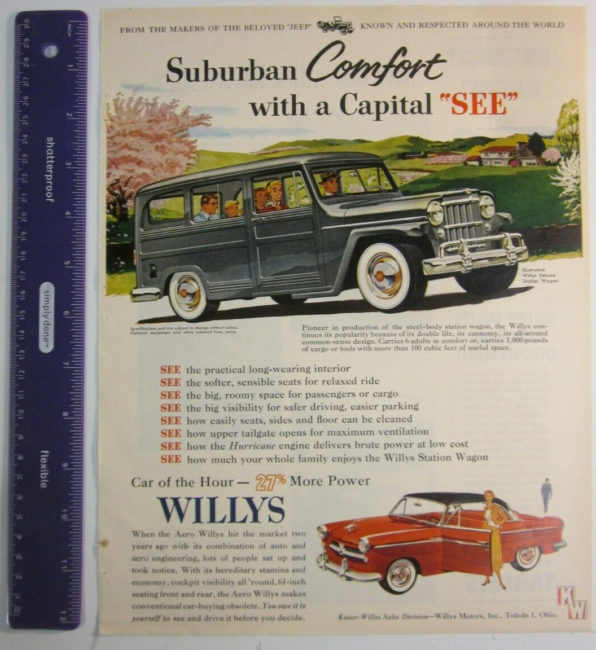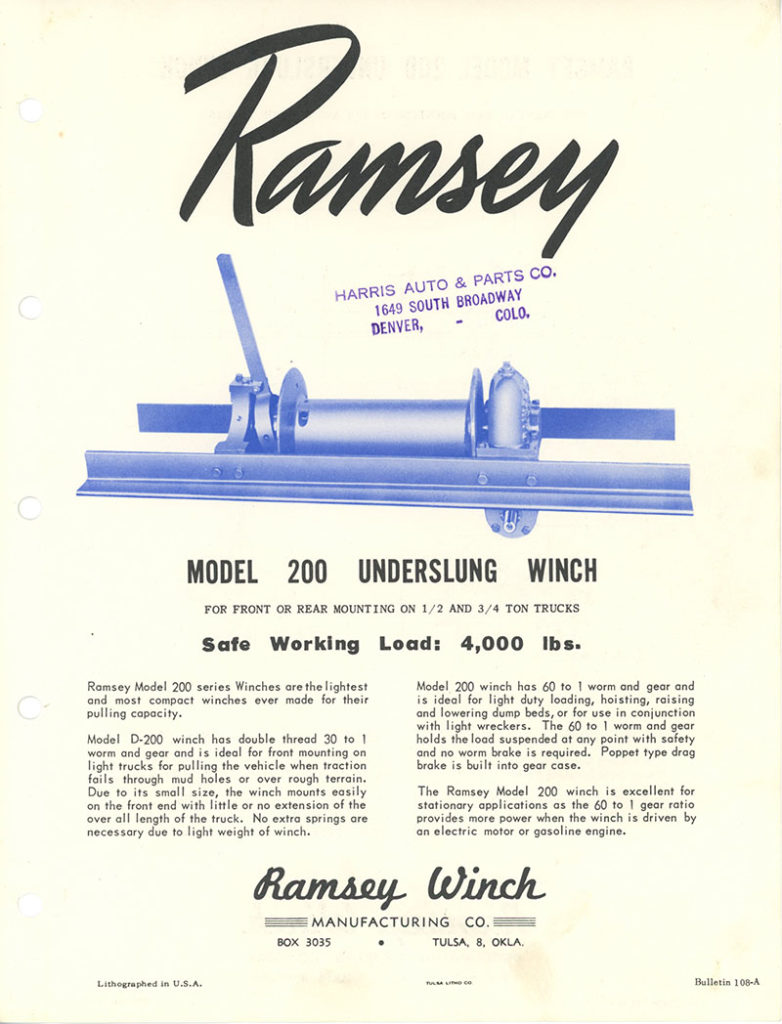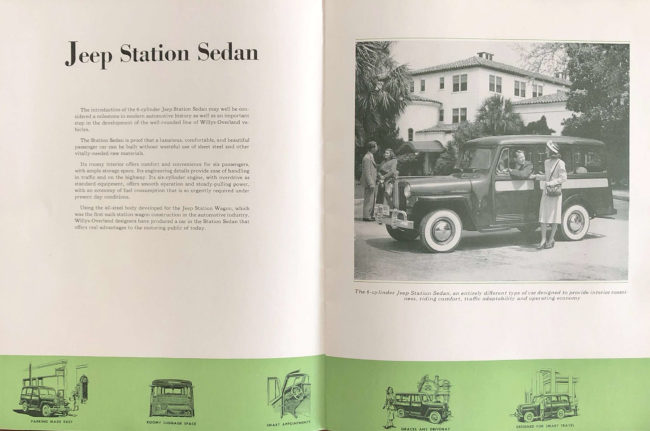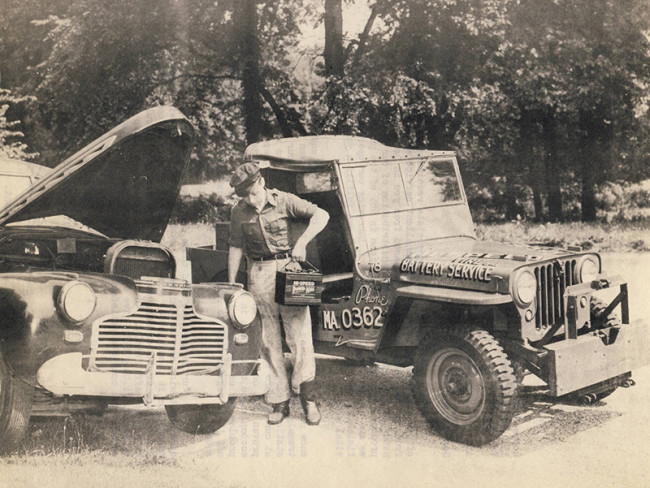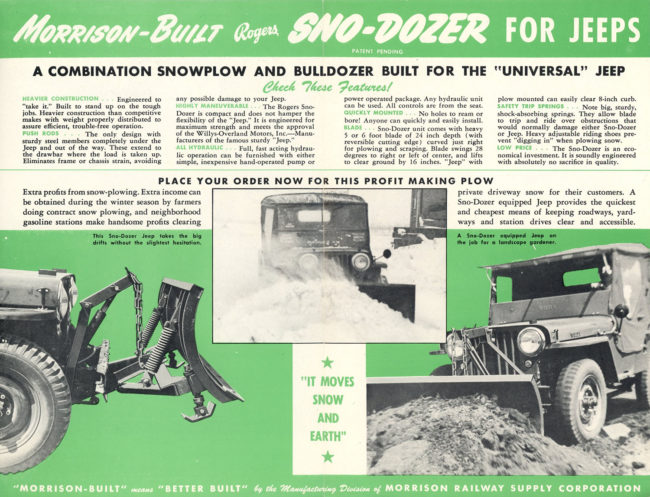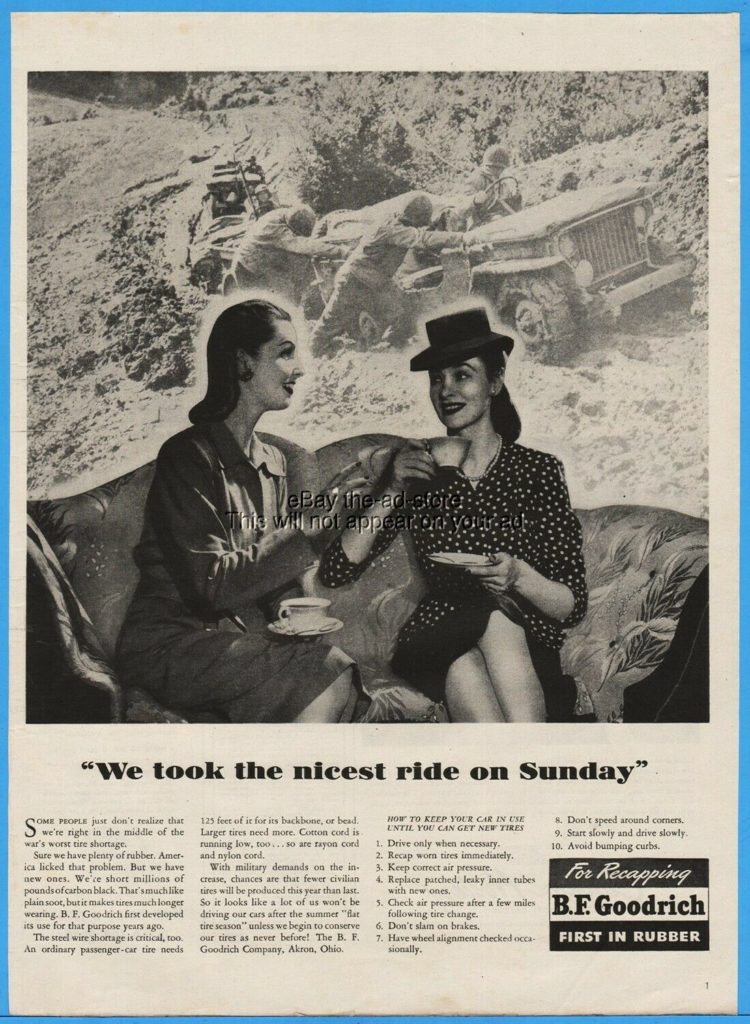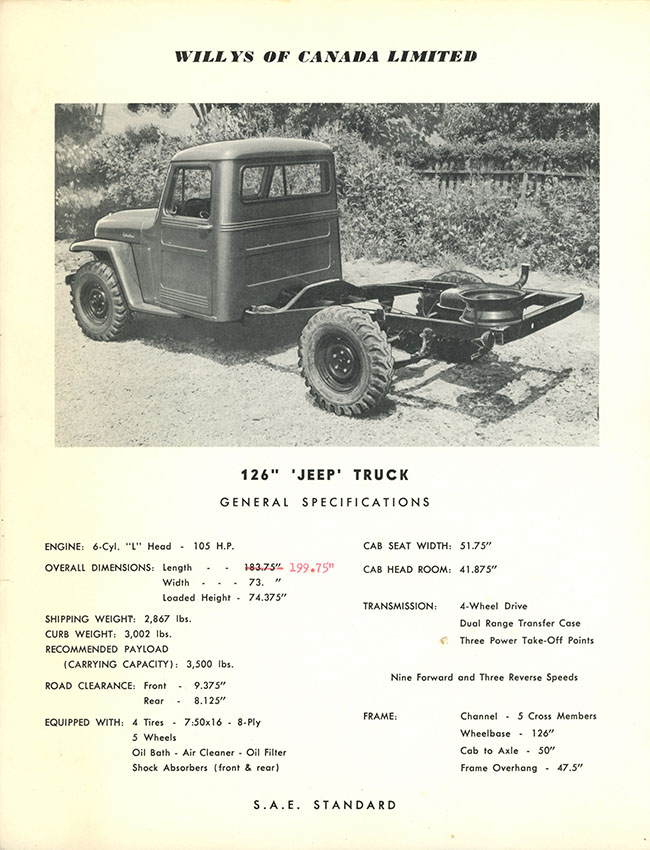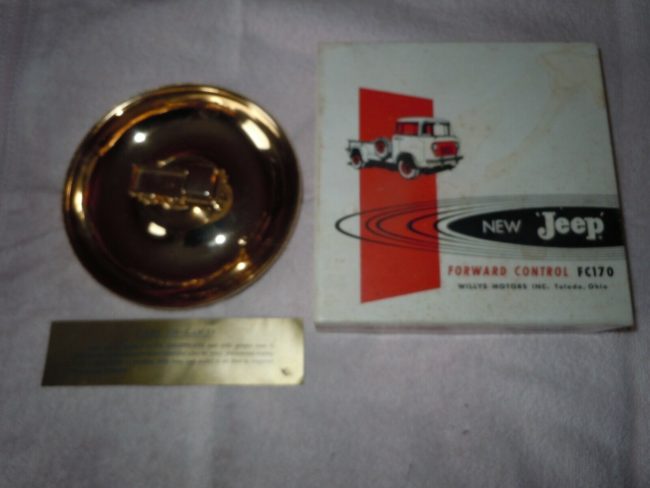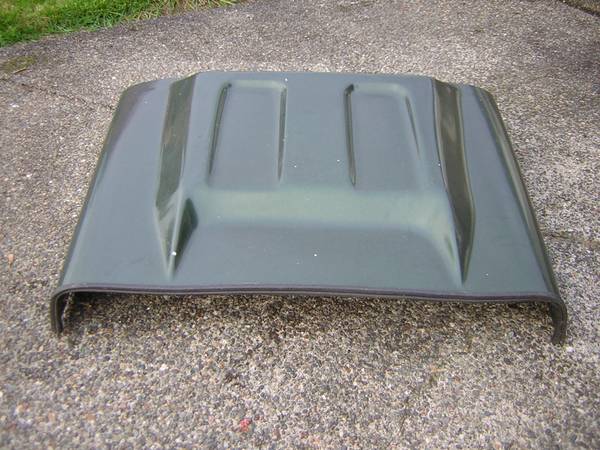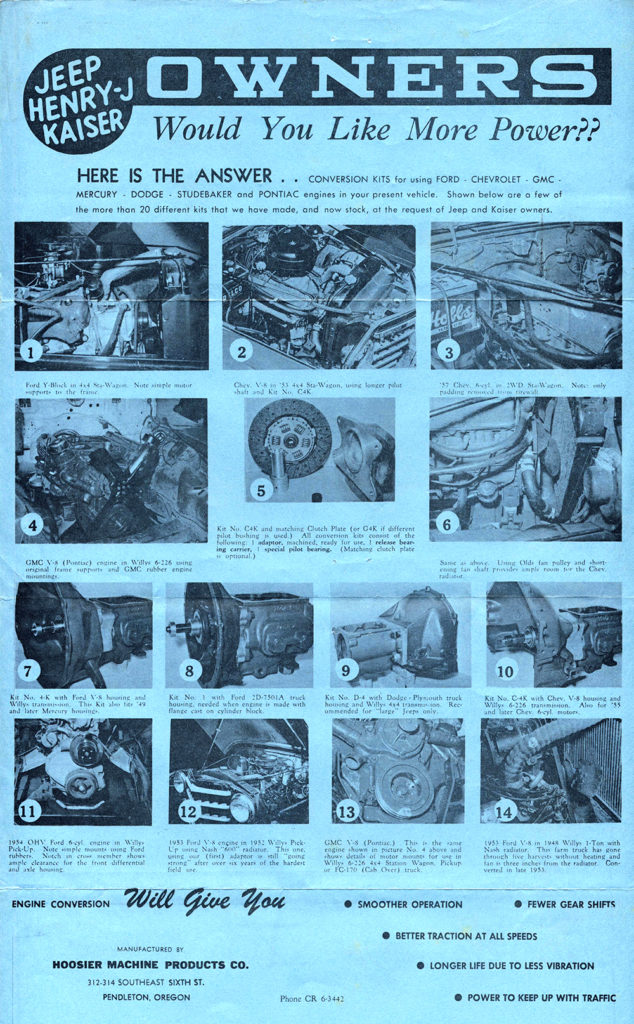This ad is part of a set of wagon-related brochures. The brochures aren’t in the best shape, but what caught my eye was the Better Homes & Gardens ad. It’s another example of Willys Motors producing what seems to be unique content for that magazine.
Advertising & Brochures Research Archives
Early 1950s Ramsey Winch Brochures
These brochures are part of an early Ramsey booklet of brochures.
This is Ramsey Bulletin 108-A, Underslung Model 200 winch:
This is Ramsey Bulletin 109-A, Underslung Model 600 winch:
Late 1948 America’s Most Useful Vehicles Brochure
UPDATE: There’s another of these brochures on eBay for $44.95 (plus $4.68 shipping).
View all the information on ebay
This 1948 jeep family brochure was likely produced in late 1948, as there’s a reference to an upcoming expectation “in early 1949” within the text. Outside of that reference, there’s no date stamp or form number. I’ve only seen few of these pop up for sale on eBay, so I snagged this one right away. I believe it represents the earliest and most complete (in pics and text) listing of the full line of jeep models for the civilian market (it lacks any military models and business-focused models, such as the Package Delivery Vans).
I especially like the illustrations. The discussion of the different factory divisions at the back was interesting, too. Including the covers, the brochure is 26 pages.
FC-150 Narrow Track Cuff Links on eBay
UPDATE: Still Available. Buy-it-now price is $99.99.
(01/05/2021) Maury shared these super cool FC-150 narrow track cuff links. They are priced at $99.
View all the information on eBay
“Very Rare Vintage late 1950’s / early 1960’s Silver Willys FC-150 Cufflinks in Tarnished but Very Good Used Condition. Stamped “NB” and “STERLING” on the inside surface of both backings.
The Jeep Forward Control is a truck that was produced by Willys Motors, later named Kaiser Jeep, from 1956 to 1965. It was also assembled in other international markets. The layout featured a cab over (forward control) design.
The Forward Control models were primarily marketed as work vehicles for corporate, municipal, military, as well as civilian use. Regular pickup box beds were standard, but customers were offered a large number of “Jeep approved” specialized bodies from outside suppliers. These ranged from simple flatbeds to complete tow trucks, dump trucks, and fire trucks. The vehicles were also manufactured under license in India and Spain.
My Father obtained these cufflinks while working in fleet sales for Willys in the Caribbean and Central & South America in the 50’s and early 60’s.”
1947 Willys-Overland Motors “A New Concept” Document
I missed out on this fascinating document yesterday on eBay. My high bid of $52.50 wasn’t quite enough, but at least we have pics of the entire document.
It’s not clear to me who the audience was for this document. The fact that it mentions the upcoming trucks suggests to me it was published in early 1947, prior to the introduction of the trucks in the summer of 1947. Maybe the document was for shareholders? Maybe it was for dealers (or prospective dealers)?
Titled “A NEW CONCEPT OF AUTOMOTIVE PRODUCTION AND DISTRIBUTION“, the document makes the argument that prior to WWII the automobile was a luxury item for most folks. As such, bigger, longer, and faster, along with yearly innovations, were necessary to attract consumers with disposable income.
However, after the war, argued Willys-Overland in the document, the automobile would become a critical part of everyone’s everyday life. As such, offering consumers an affordable vehicle, one that didn’t change dramatically every year and one that cost less to maintain, was a the vision that Willys-Overland planned to follow. This meant simple vehicles that responded to customer needs, along with lesser tweaks to each model to insure the company could keep costs down (don’t have to redesign dies, fewer factory shutdowns for model changes, etc).
So, the company’s production ideas meant simple designs catered to consumer needs rather than the latest streamlined designs. That makes sense as a strategy; but, in regards to the DISTRIBUTION portion of the document’s title, I could find nothing stating how the company’s strategy would change the distribution side of things. This document probably would have been more accurately titled, “A NEW CONCEPT OF AUTOMOTIVE PRODUCTION”.
1956 French-Canadian Ad From Kaiser-Willys of Canada on eBay
Maury spotted this jeep-family ad from Kaiser-Willys of Canada.
View all the information on eBay
“1956 Canadian Kaiser Willys print ad Jeep Universal, Wagon, & Pickup. Original magazine advertisement measures 7 X 9.5 inches (approx.).”
1945 “Sno-Jeep” Suits for Children
This unusual ad appeared in the December 18, 1945, issue of the Poughkeepsie Journal. I guess marketers figured adding the “jeep” name to most anything was a good bet for increasing sales?
1946 Testimonial from Service Station
UPDATE: The other day I realized that the jeep in this photo from a collection of early jeep information published in 2014 looks very similar to an illustrated jeep that appeared in a 1947 newspaper ad. Here’s the image and it’s associated testimonial:
Here’s the advertisement from the June 3, 1947, ad published in the Sullivan Daily Times, out of Sullivan, Indiana, that highlights the ability of the jeep to be an efficient, low-cost option as a road-service vehicle.
Morrison Snow Plow Brochure on eBay
I bought one of this seller’s Morrison brochure. It’s in very good condition. It is unclear how many of these he has. I suspect it’s from the late 1940s, given it only features CJ-2As.
View all the information on ebay
“You are buying or bidding on a rare vintage early 1950’s “The Morrison-Built Rogers Sno-Dozer For Jeeps” brochure. This was originally sold as a plow and scraper and was from the late 40’s. They were later produced by the Morrison Railway Supply Corp. Buffalo, New York. This is 5 1/2″ x 8 1/2″ opens twice to a 11″ x 8 1/2″. This is in excellent condition.(see pics)”
1955 Koenig Road Service Brochures
UPDATE: This sold years ago on eBay, but I never posted all the pics I got from the auction. It is a good example of Koenig’s Wrecker and road service brochure. Along with tow packages, it includes helper springs, PTO add-ons, push-bumpers, and more.
It is bulletin 155 (which likely means it was published in January of 1955) and then revised in April of 1955.
Tie Tack? Shirt Studs? on eBay
The seller isn’t exactly sure how these were used. But, this seems to model a CJ-5.
View all the information on eBay
“Either: Vintage Cuff Links, Tie Tack/Bar, Shirt Studs and/or Collar Bars”
March 1948 Country Gentleman Ad w/ Monroe Lift on eBay
UPDATE: This is back up for sale on eBay.
View all the information on ebay
At the very least, this Country Gentleman Magazine ad appears on page 41 of Country Gentleman’s March 1948 issue. It may appear in other issues as well. If you want the entire issue, rather than just the ad, try this link: 1948 March Country Gentleman
1954 Tractor Field Book Farm Jeep Ad
This Farm Jeep ad from this 1954 Tractor Field Book Magazine purchased off eBay shows that the Farm Jeep was still being advertised as late at 1954 (though there’s no record any Jeep Tractors were made past 1951). In fact, it’s estimated that in 1954 only 12 Farm Jeeps were produced, and the ones that were made were of the CJ-3B-Farm-Jeep variety rather than the CJ-3A version. This ad below shows the CJ-3B version, serial number prefix 454-GC2.
1945 BF-Goodrich Tires Ad on ebay
This ad with women sipping tea while soldiers push through thick mud just expired on eBay, but will likely be relisted. It seems a bit unfair to women, as if they didn’t know a war was going on. I would imagine that most women likely were the main food shoppers and had to deal with shortages beyond just rubber.
View all the information on eBay
“Condition: Near Mint
Size (approximate): 10″ X 12″
Source: Magazine
Miscellaneous: One page print advertisement”
Mid 1950s Kaiser-Willys of Canada Ads
This ad appeared in the March 28, 1955, issue of Canada’s National Post. I didn’t realize Kaiser Willys of Canada was using the phrase “Canada’s Most Useful Vehicles”.
A year later, in 1956, the company was still using the phrase. This was posted in the September 22, 1956, issue of the Financial Post:
Ten-Passenger Personnel Carrier
On eBay the other day there were these two different technical sheets from Willys of Canada Limited. The truck spec seems pretty straight forward, though the company labeled it a 126″ Jeep Truck (named for the wheelbase length … why wasn’t it the standard 118″ wheelbase?). But, the wagon had me scratching my head. Given the split windshield of wagon (I can’t tell if the truck has it), my instant thought was that these were both pre-1960 vehicles, especially given they both used the Superhurricane L-head.
As we learned yesterday, Canada didn’t have it’s own production plant until mid-1959, so if these personnel carriers are earlier than that, then they must have been made in the US and imported into Canada. The lack of the ‘hockey stick’ trim suggests they were earlier than the Traveller. Are they a precursor to the Traveller or were they concurrent to the Traveller? If the latter, why the split windshield and why wouldn’t they have been named ‘Traveller’?
Meanwhile, searches for any reference to the 126″ Jeep Truck or the Ten-Passenger Personnel Carrier haven’t yielded any newspaper ads or brochures.
Here is the Ten-Passenger Personnel Carrier spect sheet:


Here is the 126″ Jeep Truck spec sheet. Was it a coincidence that the J-300 truck introduced in 1962 was also had a 126″ wheel base?
Over the years I’ve heard about two Willys truck bed sizes, a shorter one and a longer one, but all the info I’ve read indicated the Willys Jeep truck beds were all the same size. If a bed was made to fit this longer wheelbase, it may have meant the creation of a longer bed. This might explain the rumor of the longer beds?
Gold-Plated FC-170 Ashtray with Box **SOLD**
UPDATE: **SOLD** Was listed at $175.
(03/01/2021) This rare package includes a plaque and the original box (pretty cool box). The starting bid is $175.
“THIS AUCTION IS FOR A WILLYS JEEP MODEL FC 170 GOLD PLATED ASH TRAY IN ITS ORIGINAL BOX AND INCLUDES “CARE” INSERT.
WILLYS MOTORS INC. OF TOLEDO, OHIO
GOLD PLATED WITH 22K GOLD PLATE
THE ASHTRAY IS IN GREAT SHAPE WITH MINIMAL WEAR.
THE BOX IS IN GODD SHAPE ALSO WITH GOOD COLOR AND GRAPHICS.
50’S VINTAGE
A NICE, RARE, JEEP TOY”
Mid-1950s Willys Motors Brochures on eBay
Maury shared this eBay ad. The price is $65, but the seller will consider offers. The “Jeep Means Business is from 1954”, the “Public Service” is from 1955, as is the “Completely New” CJ-5 brochure. The DJ-3A brochure is from 1956.
1973 Bobcat Introduces New Products
UPDATE: Richard Darr from Washougal Classic Jeeps owns a Bobcat body that still had a pair of the fiberglass gas tanks. Here are two pics of each tank. He told me they fit really well inside the bobcat body. He’s working on reproducing the tanks in aluminum for himself.
Here are the pics of the passenger side tank. Above you can see a Bobcat body.
Here is the driver’s side tank:
===================
Published March 17, 2021: For a great price, I bought some 1973 issues of Four Wheeler off of eBay. In turns out that the July 1973 issue of Four Wheeler Magazine had a special section devoted to new fiberglass products. Even better, Fred Weis’ Bobcat business introduced three new products in that issue, answering a couple questions that I had.
Before I begin, there are several posts about Bobcat bodies and the related Parkette bodies. At some point I will combine them into a longer narrative, but, for now, here’s a quick timeline:
1969 – The First Bobcat body: Fred Weis built his first body, an approximately 150lb body using plywood for strength, per this February 1970 article in Four Wheeler Magazine.
1970 – Lighter Race Body: Fred builds a lighter body design more for racing, dropping the body weight to around 100lbs. One these first bodies was used successfully by Roy Williams during the 1970s for racing. (This weight info comes from a September 1973 ad shown below):

1971- Announces the CJ-3B Body: An Advertisement in the PNW4WDA’s Region 1 contact booklet included an ad from Fred indicating he was making CJ-3A AND CJ-3B bodies.
It might seem strange to see the “Not a copy!” phrase at the top of the ad, followed by “The Original Fiberglass Replacement Body” within the ad. I believe this reflects Fred’s frustration at Paul Parker rebranding the Bobcat body with side stripes and calling it a Parkette body. Assuming that explains the inclusion of the phrases, this puts the introduction of the Parkette body around 1970. The 1970 timeline also fits the purchase of a Parkette by Jim Carter, which must have happened around 1971 or 1972.
Now for our current post. In 1973, Fred introduced perhaps the most iconic item he ever produced, the Bobcat hood. I don’t know how or why he designed it the way he did, but it became a signature piece. Below is the July 1973 listing in Four Wheeler Magazine.
First, you can see that Fred was experimenting with a new type of body style. It appears he increased the size of the lip around the edge of the body’s rear, perhaps to strengthen it so he could lay thinner glass. It’s likely that this was the style of Bobcat body I bought back in 2008:

The fiberglass gas tanks were a surprise to see. I’ve never run across these. They likely failed to hold gasoline safely. It would take a special resin compound to be effective over the long term, at least that’s according to this motorcycle thread.
Finally, we have the brand new fiberglass Bobcat hood. Whether this came before or after the Bobcat teardrop hood isn’t clear, but it would seem to me that the teardrop is so much less sophisticated of a design that I could imagine he made some of those first before creating the classic Bobcat hood. Here’s a great example of the hood: (see more examples of the low hood and high hood versions of this iconic hood)
Also included in the July 1973 fiberglass section was this ad. It seems Willamette Wheel was offering the Bobcat body for sale, without labeling it as such in the ad. However, a close look at the tailgate clearly shows it is a Bobcat tailgate.
It’s not clear how many other parties were working with Fred, but at least one, Don Prine, managed to get his business card inserted into a CJ-3B version of the classic hood:
As I collect more 1970 Four Wheeler magazines I hope to learn more about the Bobcat and Parkette timelines, though I’ve yet to find anything printed about the Parkette body (no ads or articles yet).
Hoosier Machine Products’ Jeep Conversion Kits
UPDATE: I was surprised to see that Hoosier advertised in Four Wheeler Magazine for several months during 1973 (possibly longer).
===================
ORIGINALLY PUBLISHED JUNE 6, 2019: In the early 1960s, Hoosier Machine Products out of Pendleton, Oregon, (just an hour south of me) began selling conversion kits for jeeps. The company’s kits allowed the repowering of jeeps using Ford, Chef, GMC, Mercury, Dodge, Studebaker and Pontiac engines. That’s a pretty impressive, wide range of options, especially for a company out of Pendleton, which was pretty remote at the time. But, given the long distances Pendleton owner’s jeeps had to travel to reach other towns and the existence of the nearby, steep Blue Mountains, which provided endless jeeping possibilities, perhaps there was a reason Pendleton jeeps need more power?
Also, a big thanks go to Maury for spotted this brochure for me!
June 1950 Ad for 1/2 Ton Truck on eBay
This June 1950 Ad highlights the new Hurricane Powered half-ton truck from an unknown magazine.
View all the information on Ebay
“Original magazine advertisement measures 10 X 13 inches (approx.).”
Desert Dog History and Ads
UPDATE: After spotting an ad I hadn’t published yet (seen below), I realized that there was Desert Dog history that existed among various posts. So, this combines all that into more of a narrative.
==========================
If you have read eWillys for any length of time, you know I’ve been a fan of Desert Dog tires for years. I still have eight desert dogs, some solid lettering and some outlined, as shown in the pic below:
According to Louis Larson, the Desert Dog tire was launched in 1970. He knows this, because in 1970 he became the first person to test out the new style of tires (see the bottom of this CJ-3B Page article). The tires were given to Louis for testing and photographing.
David Maxwell, a former Formula tires salesman, reported that the tires were always made by Armstrong, but marketed through the Formula brand, the president of which was a friend of David’s (see David’s comment and many others on this post). The company made a large number of retreads, so a number of tires also had Firestone on the side, too.
The tires proved popular quickly. Les Schwab was a big fan of them and ran them on his jeep (jeeps?). He also sold both new and retread tires out of his main shop in Prineville (see Les Schwab’s biography here).
For PNW jeepers, the tires were a perfect blend for racing and for jeeping and the varied terrains of the PNW (sand, gravel, rocks, mountain sides, mud, etc … as Joe1148 highlights in his comment here .. though I can attest to it as well). On the downside, their road life was short (some estimate about 10k miles) and they tended to be noisy. The tires’ popularity gained them prominence, and soon they were added to charts showing tire options, such as this January 1972 ad:
By 1973, Desert Dogs were being advertised in Four Wheeler Magazine (ads at the bottom of this post) and sold across the country. This Smith Jeep, Inc. ad from North Franklin, Connecticut, in the July 1973 issue of Four Wheeler Magazine is one example of an East Coast offering:
Eventually, the Formula brand expand its offering. I don’t know when each of these tires was introduced (I think this ad is from 1975, but have to confirm it), but Formula was soon offering more tires choices:
1973 World Plastics Fiberglass Racing Shells
The July 1973 and August 1973 issues of Four Wheeler Magazine included these two ads for fiberglass racing shells. I’m not sure when World Plastics began advertising in the magazine, but I doubt it had been for very long. The ad on the right shows a full-body size flat fender shell, while the ad on the right shows a narrow body shell (both Bobcat and Parkette also produced racing shells).
I don’t know how long these were offered, what happened to the shells, or what happened to the World Plastic’s company.
Willys Jeep Newspaper Ad During 1944
UPDATE: Maury shared a magazine page on eBay that contains a similar ad to the one shown at the bottom of this page. It’s almost identical, except that Jeep now appears with single-quotes.
The use of single quotes outside of a set of double quotes is uncommon. One editor summed it up best by describing it’s use this way: If a phrase or a word is uncommon or you are highlighting it to the reader for a particular reason – for example, as a neologism or a conscious use of jargon – use single quotation marks. Any punctuation sits outside single quotation marks. Thus, I suspect Willys-Overland felt they could defend the use of ‘JEEP’ by describing it’s presence as a descriptive use of jargon, rather than an attempt to back into the trademarking of the name. However, backing into the trademark using single quotes was exactly what the company was doing.
To answer the question I asked in the original post (was the bottom ad a local dealer or national corporate campaign), given these two ads appeared in two different national magazines, it seems likely this simple ad construction was part of a national campaign by Willys-Overland to begin prepping the public for post war jeep sales, This particular ad appeared in the October 1944 issue of Successful Farming.
This page is for sale on eBay:
The purposeful addition of the single quotes reflects a similar change seen in the iconic Saturday Evening Posts during 1944, as demonstrated in these ads. The first highlighted ad of February 05, 1944, was the first time Willys-Overland replaced the prominent WILLYS stamp on the Post ads with JEEP (or in this case JEEPS) with no single quotes.
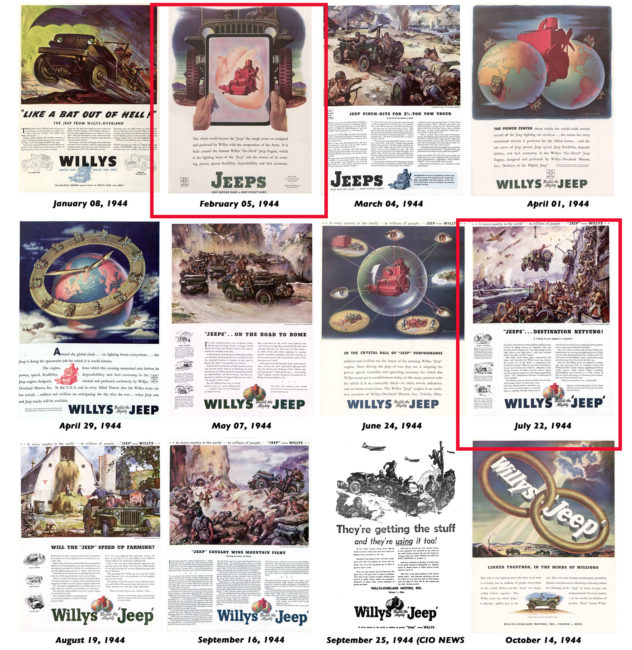
See all the Willys-Overland WWII ads 1941-1946 here: http://www.ewillys.com/2019/03/10/willys-overland-ads-in-the-saturday-evening-post-1942-mid1946/
What isn’t quite the same is that the Midland Journal ad below without the single quotes lasted longer (through October 6 1944) than the Saturday Evening Post ads. Perhaps Willys-Overland purchased several months of ads beginning in June of 1944 right before the addition of the single quotes too place? However it happened, what the ad above shows is that Willys was correcting the single quotes’ issue across its advertising.
Why did the company ad the single quotes in the first place? As I argued in this long post on Willys Overland’s changing identity during WWII, I believe it stems from the 1944 congressional inquiry into the company’s efforts to trademark the JEEP name.
========================
Originally published March 29, 2020: Here’s an unusually small and succinct ad that appeared seven times in the Midland Journal out of Rising Sun, Maryland, from June 30, 1944, through October 6, 1944. I’ve yet to run across this specific ad elsewhere.
One thing to note is that in July of 1944, Willys-Overland began using single quotes around the word Jeep like this ‘Jeep’ major magazine ads, yet that was not done in any of the newspaper ads in the Midland Journal, as shown below. (Ed note …. Yeah, I know, not earth shattering news, but I never know when little details like this will add up to some insight).
The ad shown below was in the August 11, 1944, issue of the Midland Journal:
This shows how small the ad was within the newspaper page.
February 1962 Issue of Jeep News
This February 1962 issue of Jeep News includes two good photos on page four of the DJ-3A-based mobile bar that was at the Las Brisas resort in Mexico. I have a color photo of that, too. It might be fun to recreate one of those.
Page three shares a little info on a twenty-eight page dealer booklet entitled, “Your Ten Major Retail Markets”. That’s a book I’ve yet to see anywhere.

